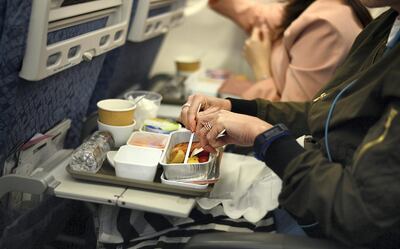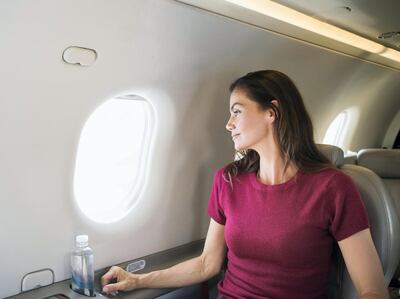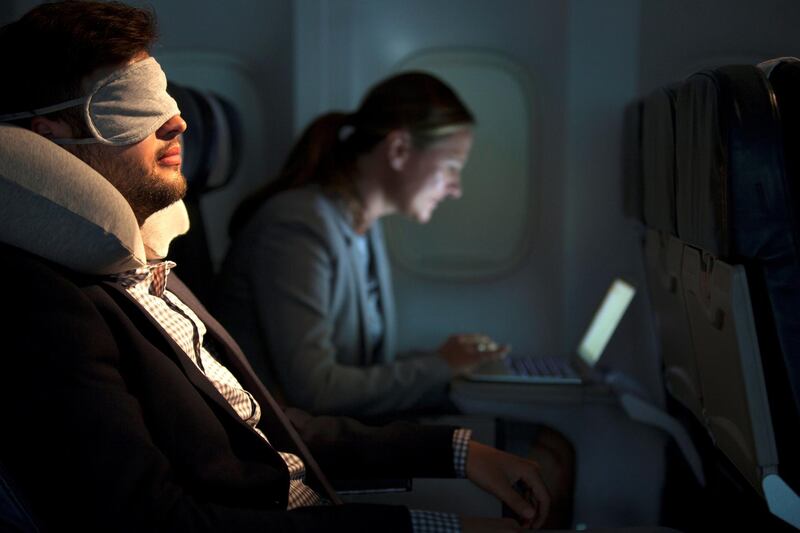There's nothing more annoying than being ill on holiday. Which makes getting there and back doubly important, because aircraft passengers are more susceptible to sniffles, stomach bugs, respiratory infections, swollen limbs or, worse, blood clots during or after their trip. But there are several precautions you can take before you're enclosed with hundreds of others, in a pressurised metal box, 10,500 metres above the ground.
Hand hygiene
Germs are the top cause of illness on aircraft, and hand hygiene is the number one solution to keep them at bay. According to the World Health Organisation, basic hand sanitation is effective in avoiding a wide range of infections, and regular hand-washing should not be skipped even if you’re wearing a pair of gloves.
Mohamed Samir, regional medical director of Mundipharma Middle East and Africa, says: “On a flight, wash your hands thoroughly with soap or disinfectant every two hours; the golden hand-wash standard is to use hot water, lather your hands well, making sure to wash the back, and between the fingers and fingernails.
“Trimming your nails in advance can further help in preventing an infected nail bed,” he adds.
Carry an anti-bacterial hand sanitiser, such as Betadine, Dettol or Purell, with at least 60 per cent alcohol, and ensure you massage the gel all over your hands and fingers until it’s dry. Also, because germs are often passed through hands, keep them away from your face, and avoid touching the eyes and mouth.
Your own person aside, Dr Hanan Sheikh Ibrahim, consultant internist and geriatrician at the Medical Subspecialty Institute at Cleveland Clinic Abu Dhabi, notes: "The most common areas of contamination in aircraft and at airports include hard surfaces, such as armrests, food trays, knobs, faucets, the seat-belt buckle, the security plastic bins and the bathrooms. Although it might be difficult to avoid contact with some of these objects, travellers can minimise the risk of contracting germs by sanitising these surfaces with wet wipes or a hand sanitiser."

Dehydration
This is another common pitfall of air travel. From affecting your external appearance to distressing your internal organs, the loss of moisture that inevitably results from the high altitudes and cabin pressure leads to fatigue, dry skin, eyes and lips, and can even cause life-threatening breathing problems.
"The ideal practice is to drink a litre of water every four hours, that is about one glass every hour," Mr Samir says. "The recirculated air in planes is very dry, almost like desert air, and can affect the mucous membranes in your nose and throat, making it easier for viruses and bacteria to enter, so hydration is key."
If you have sinus problems a nasal saline spray would be useful, as would eye drops and steering clear of drinks that will dehydrate you, such as carbonated soft drinks, coffee and alcohol.
Skincare
Skin typically fares well at a humidity level between 40 per cent and 70 per cent. The levels of humidity in aeroplanes ranges between 4 per cent and 20 per cent – which results in a loss of about 1.5 litres of water during a three-hour flight. It can take days for your skin to fully recover and start the regeneration process.
Drinking plenty of water aside, apply a lavish amount of moisturiser before you board. Once you’re in the air, even the most hydrating cream will not be as effective because the dry air it’s surrounded by does not yield much moisture. This is why you need to reapply a cream each time you wash your face or even wipe your mouth. Face mists – refreshing as they might feel – are a complete no-no, because these tend to evaporate even faster on board, leaving your skin more dried out. An effective sun-blocking product is a must if you’re flying in the day, or will pass a time zone when the sun is up. Above all, eradicate all traces of make-up.
“Make-up on a flight is an unforgivable sin against skin. Wipes, while convenient, can be harsh on your skin’s pH balance,” says Bianca Estelle, Harley Street skincare clinician and founder of Bea Skin Care. “Prepping your skin before and taking extra care on the plane and after you disembark can help fight the effects of the dry air, leaving you glowing for your holiday.”

Jet bloat
Feeling bloated is not uncommon after an extended flight. This happens because an increase in the air pressure surrounding you corresponds to an expansion of the air in your stomach and limbs. While "jet bloat" subsides in a few hours or overnight, it can cause deep vein thrombosis or blood clots in the legs, especially for frequent or long-haul flyers.
"Maintaining circulation is crucial to prevent the development of blood clots and can be achieved by hydration and simple exercises such as rotating your ankles in a circular motion, and keeping your feet flat on the ground then bringing your heel up and down," says Cleveland Clinic's Dr Ibrahim.
Dr Tasmia Tahmeed, Aetna International’s general practitioner, says: “Try standing up at regular intervals and take short walks when you can. You can wear special stockings to prevent clot formations in your legs. And try to adjust your sleep schedule to the time zone you’re visiting or returning to as quickly as possible.”
Vaccination
Finally, do a bit of reading on the common epidemics and prevalent diseases in pockets of the country you're visiting and protect yourself by getting the necessary vaccines, even if they are not required by law. For example, yellow fever and tetanus shots for a safari in Kenya or hepatitis A and B before a sojourn to a remote island in the Philippines. Consider taking a flu shot seven to 10 days before travelling to boost your body's immunity, if you haven't taken it already.
“It is also smart to carry certain basic medical supplies, such as sunscreen, paracetamol and a reserve supply of any regular medication that you take, as well as carrying a doctor’s note or prescription. Always ensure you have valid travel insurance even if it’s for a short duration and make sure you are well aware of your medical benefits,” Dr Tahmeed says.
To this, Dr Elhadi Eltayeb Abbas, senior consultant and head of the Internal Medicine department at RAK Hospital, adds: "People who are suffering from diseases that make them susceptible to infections or are taking drugs that compromise their immunity should postpone their travels if they feel they could endanger other passengers.
“Airlines, on their part, should implement measures such as providing better modes of hand hygiene and standardising air handling with proper air filtration. They should also ensure better cleaning and disinfection for seats and utensils that are reused. For preventive measures, they should adopt better tracking methods for passengers who are infected or exposed to a disease. We need comprehensive campaigns to educate the public,” he says.
Until that happens, though, be mindful of your well-being by following the precautions listed here so that you don’t compromise your safety and, in turn, your merrymaking, on your next holiday.
_________________________
Read more:
[ Dubai's Glenville Nutrition Centre aims to be a one-stop solution to women’s health issues ]
[ UAE life coach Shereen Mitwalli has created an all-encompassing personality test ]
[ The worrying effect perfectionism has on us ]
_________________________







